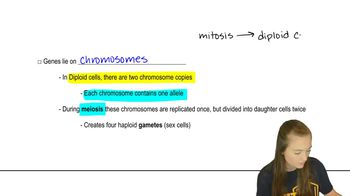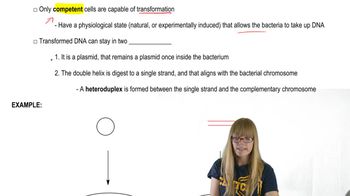Three pairs of genes with two alleles each (A₁ and A₂, B₁ and B₂, and C₁ and C₂) control the height of a plant. The alleles of these genes have an additive relationship: Each copy of alleles A₁, B₁, and C₁ contributes 6 cm to plant height, and each copy of alleles A₂, B₂, and C₂ contributes 3 cm. What is the expected height of a plant with the genotype A₁A₂B₂B₂C₁C₂?
Table of contents
- 1. Introduction to Genetics51m
- 2. Mendel's Laws of Inheritance3h 37m
- 3. Extensions to Mendelian Inheritance2h 41m
- 4. Genetic Mapping and Linkage2h 28m
- 5. Genetics of Bacteria and Viruses1h 21m
- 6. Chromosomal Variation1h 48m
- 7. DNA and Chromosome Structure56m
- 8. DNA Replication1h 10m
- 9. Mitosis and Meiosis1h 34m
- 10. Transcription1h 0m
- 11. Translation58m
- 12. Gene Regulation in Prokaryotes1h 19m
- 13. Gene Regulation in Eukaryotes44m
- 14. Genetic Control of Development44m
- 15. Genomes and Genomics1h 50m
- 16. Transposable Elements47m
- 17. Mutation, Repair, and Recombination1h 6m
- 18. Molecular Genetic Tools19m
- 19. Cancer Genetics29m
- 20. Quantitative Genetics1h 26m
- 21. Population Genetics50m
- 22. Evolutionary Genetics29m
3. Extensions to Mendelian Inheritance
Overview of interacting Genes
Problem 15b
Textbook Question
A plant line with reduced fertility comes to the attention of a plant breeder who observes that seed pods often contain a mixture of viable seeds that can be planted to produce new plants and withered seeds that cannot be sprouted. The breeder examines numerous seed pods in the reduced fertility line and counts 622 viable seeds and 204 nonviable seeds.
Propose an additional experiment to test the genetic mechanism you propose. If your hypothesis is correct, what experimental outcome do you predict?
 Verified step by step guidance
Verified step by step guidance1
Propose a hypothesis: Based on the observation of viable and nonviable seeds, hypothesize that the reduced fertility may be due to a genetic mechanism such as a recessive lethal allele. This allele could cause nonviable seeds when present in a homozygous state.
Design an experiment: Cross plants from the reduced fertility line with plants from a wild-type line that does not exhibit reduced fertility. This will allow you to observe the inheritance pattern of the viable and nonviable seeds in the offspring.
Predict the outcome: If the hypothesis of a recessive lethal allele is correct, the offspring from the cross should show a Mendelian ratio of 2:1 for viable to nonviable seeds. This is because the homozygous recessive genotype would result in nonviable seeds, while the heterozygous and homozygous dominant genotypes would produce viable seeds.
Perform the cross and collect data: Allow the plants to self-pollinate or cross-pollinate as per the experimental design. Count the number of viable and nonviable seeds in the offspring to determine if the observed ratio matches the predicted 2:1 ratio.
Analyze the results: Use a chi-square test to compare the observed ratio of viable to nonviable seeds with the expected 2:1 ratio. If the chi-square test supports the hypothesis, it provides evidence for the proposed genetic mechanism. If not, consider alternative hypotheses and repeat the experiment with modifications.
 Verified video answer for a similar problem:
Verified video answer for a similar problem:This video solution was recommended by our tutors as helpful for the problem above
Video duration:
2mPlay a video:
Was this helpful?
Key Concepts
Here are the essential concepts you must grasp in order to answer the question correctly.
Genetic Inheritance
Genetic inheritance refers to the process by which traits and characteristics are passed from parents to offspring through genes. Understanding inheritance patterns, such as Mendelian ratios, is crucial for predicting the outcomes of breeding experiments. In this case, the ratio of viable to nonviable seeds may suggest a genetic basis for fertility issues, potentially indicating dominant or recessive traits affecting seed viability.
Recommended video:
Guided course

Diploid Genetics
Phenotypic Variation
Phenotypic variation is the observable differences in traits among individuals in a population, which can arise from genetic differences, environmental factors, or a combination of both. In the context of the plant line, the presence of both viable and nonviable seeds indicates phenotypic variation that may be linked to underlying genetic mechanisms. Analyzing this variation can help identify specific traits associated with fertility.
Recommended video:
Guided course

Genomic Variation
Experimental Design
Experimental design is the process of planning an experiment to ensure that it effectively tests a hypothesis. In this scenario, the breeder could conduct a controlled cross between the reduced fertility line and a known fertile line to observe the inheritance of seed viability. The predicted outcome, if the hypothesis is correct, would be a specific ratio of viable to nonviable seeds in the offspring, supporting the proposed genetic mechanism.
Recommended video:
Guided course

Transformation

 7:56m
7:56mWatch next
Master Interacting Genes Overview with a bite sized video explanation from Kylia
Start learningRelated Videos
Related Practice
Textbook Question
497
views
